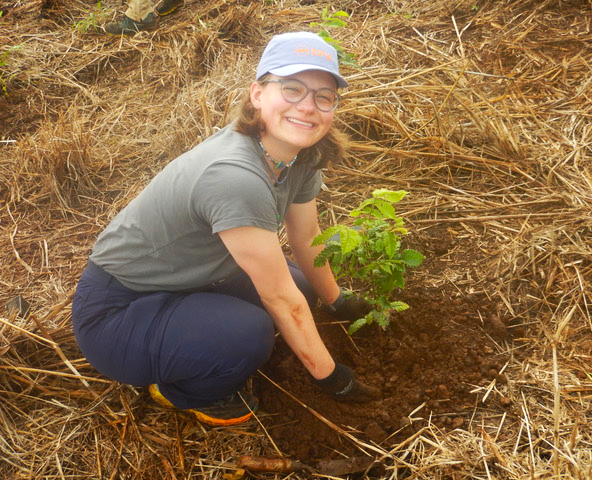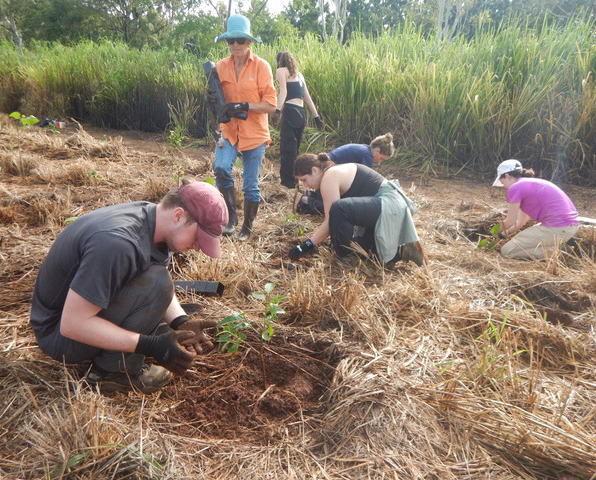Restoring the critically endangered Mabi rainforest while in Australia
April 19th, 2024 | SIT Study Abroad
by Alex Bailey, Aidyn Levin, and Emily Healy (Skidmore College)
This story and photos were originally published in Hamilton College's The Spectator. They are reprinted here with permission.

Photo courtesy of Alex Bailey
From Feb. 22 to Feb. 24, the School for International Studies: Rainforest, Reef and Cultural Ecology students spent their time reforesting a section of the Mabi rainforest in the Atherton Tablelands, Australia. Mabi rainforest is critical to many species in Australia. “Mabi” is actually the Aboriginal name for tree kangaroo, one of the species that lives in Mabi rainforests. It also houses species endemic to the Wet Biotropics Region, such as Boyd’s Forest Dragon (Lophosaurus boydii). Thus, it is essential that Mabi rainforests are protected. However, currently less than four percent remains. This is where TREAT (Trees for the Evelyn and Atherton Tablelands) comes in.
TREAT is a volunteer-based organization that was founded in 1982 by Joan Wright and Geoff Tracey. Their goals were to replant rainforest trees and plants in order to help revegetate areas in the Evelyn and Atherton Tablelands. As of 2024, TREAT has more than 400 members who put in the hours, with numerous plantings during Australia’s wet season (Nov.-April) and preparation of hundreds of native species during the dry season (May-Oct.). SIT students worked very closely with TREAT members as well as members of the Queensland Parks and Wildlife Service over the course of the reforestation project.
The act of reforestation is more than placing a sapling in a freshly dug hole. In fact, it is a multi-day, multi-year project. First, the location of reforestation must be decided upon and the land must be prepared, including mowing and removing standing grasses that could hinder the growth of the new trees. From there, each hole must be measured out and marked to tell the auger operator where to dig — in our case, that was 2,500 holes! To continue to help the new trees successfully take root, each hole is then prepared with fertilizer and water crystals, or “goop,” as we came to call it. This will ensure that each tree will have the adequate nutrients to get started and will have a water source during the dry season.
Now the part we’ve been waiting for--the planting. Some of the species planted included Celery Woods (Polycias elegans), distinctive for its celery scent, and Bleeding Heart (Homalanthus populifolius), which has red heart-shaped inner leaves. Both of these species, along with many others planted, are early succession species that are native to the Mabi forest type. In addition, these trees will act as a magnet for birds in the area, who will deposit seeds from the surrounding forest when perched. Over the course of several hours and with around 100 volunteers, each tree is carefully placed in their hole and wished good luck. In the following years, fellow TREAT volunteers and the local Queensland Parks and Wildlife Service will follow up on the site, ensuring the seedlings’ success.
Reforestation is a long-term process, and nobody knows how long it will take for replanted forests to fully resemble Mabi forest. It’s also about more than just the trees — as TREAT explains on their website, “the aim of rainforest restoration is to generate a forest that is self-sustaining, with intact ecological processes, and that creates a habitat for the organisms that naturally occur in the area.” In the first few years after planting, trees spring up quickly, offering somewhat instant gratification for the work put in. Insects begin to dwell in the sites, as do birds and reptiles. But rainforests are extremely complex forests, with many other types of plants including epiphytes, vines, and shrubs. Over time, these species should appear, as birds and small mammals bring in seeds. The site we planted is right across from a remaining fragment of Mabi forest in Wongabel State Forest, which will hopefully speed up the rate at which various species move into the new habitat. But it will take years for the site to look like a real rainforest and provide habitat for larger animal species like tree kangaroos and probably hundreds before it will be indistinguishable from original Mabi forest.

Photo courtesy of Alex Bailey
Who knows what the years will bring? In the meantime, though, the diverse, dedicated, and ever-expanding group of TREAT volunteers will continue with their noble goal of planting, in their words, “the right tree in the right place for the right reason.”
